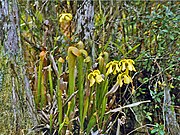
Pitcher plants are several different carnivorous plants that have modified leaves known as pitfall traps—a prey-trapping mechanism featuring a deep cavity filled with digestive liquid. The traps of what are considered to be "true" pitcher plants are formed by specialized leaves. The plants attract and drown their prey with nectar.
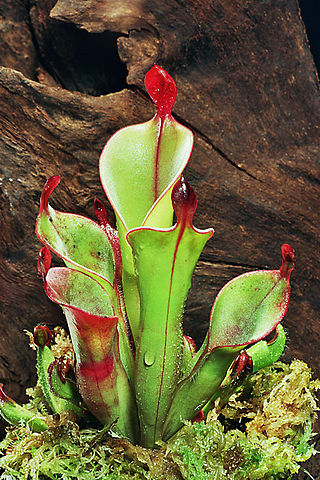
Sarraceniaceae are a family of pitcher plants, belonging to order Ericales.

The Okefenokee Swamp is a shallow, 438,000-acre (177,000 ha), peat-filled wetland straddling the Georgia–Florida line in the United States. A majority of the swamp is protected by the Okefenokee National Wildlife Refuge and the Okefenokee Wilderness. The Okefenokee Swamp is considered to be one of the Seven Natural Wonders of Georgia and is the largest "blackwater" swamp in North America. The Okefenokee Swamp was named after the Choctaw phrase, "Land of the Trembling Earth".
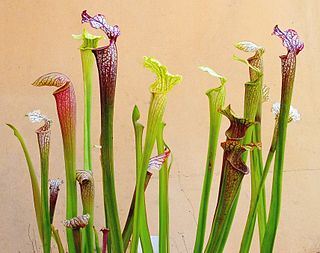
Sarracenia is a genus comprising 8 to 11 species of North American pitcher plants, commonly called trumpet pitchers. The genus belongs to the family Sarraceniaceae, which also contain the closely allied genera Darlingtonia and Heliamphora.

The genus Heliamphora contains 23 species of pitcher plants endemic to South America. The species are collectively known as sun pitchers, based on the mistaken notion that the heli of Heliamphora is from the Greek helios, meaning "sun". In fact, the name derives from helos, meaning marsh, so a more accurate translation of their scientific name would be marsh pitcher plants. Species in the genus Heliamphora are carnivorous plants that consist of a modified leaf form that is fused into a tubular shape. They have evolved mechanisms to attract, trap, and kill insects; and control the amount of water in the pitcher. At least one species produces its own proteolytic enzymes that allows it to digest its prey without the help of symbiotic bacteria.
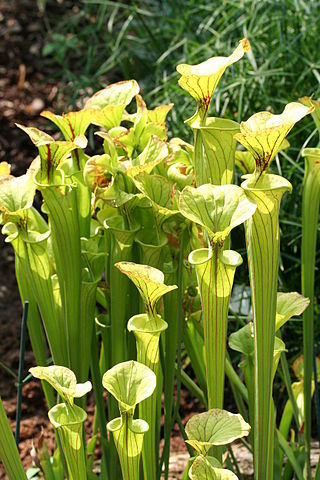
Sarracenia flava, the yellow pitcherplant, is a carnivorous plant in the family Sarraceniaceae. Like all the Sarraceniaceae, it is native to the New World. Its range extends from southern Alabama, through Florida and Georgia, to the coastal plains of southern Virginia, North Carolina and South Carolina. Populations also exist in the Piedmont, Mendocino County, California and mountains of North Carolina.

Sarracenia purpurea, the purple pitcher plant, northern pitcher plant, turtle socks, or side-saddle flower, is a carnivorous plant in the family Sarraceniaceae.

Nepenthes klossii is a tropical pitcher plant endemic to New Guinea.

Sarracenia rubra, also known as the sweet pitcherplant, or purple pitcherplant, is a carnivorous plant in the genus Sarracenia. Like all Sarracenia, it is native to the New World. Its range extends from southern Mississippi, through southern Alabama, the Florida panhandle and Georgia, to the coastal plains of North Carolina and South Carolina.

Heliamphora minor is a species of marsh pitcher plant endemic to Auyán-tepui in Venezuela. As the name suggests, it is one of the smallest species in the genus. It is closely related to H. ciliata and H. pulchella.
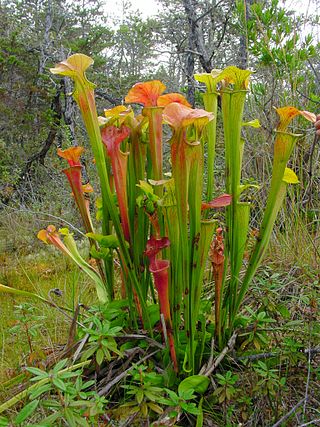
Sarracenia oreophila, also known as the green pitcherplant, is a carnivorous plant in the genus Sarracenia. It has highly modified leaves in the form of pitchers that act as pitfall traps for prey. The narrow pitcher leaves are tapered tubes that rise up to 75 centimetres (30 in) from the ground, with a mouth 6 to 10 centimetres in circumference Like all the Sarracenia, it is native to North America. Sarracenia oreophila is the most endangered of all Sarracenia species, its range limited to a handful of sites in northern Alabama, North Carolina, Georgia, and—historically—Tennessee.

Sarracenia alata, also known as yellow trumpets, pale pitcher plant or pale trumpet, is a carnivorous plant in the genus Sarracenia. It is native to North America.

Sarracenia leucophylla, also known as the crimson pitcherplant, purple trumpet-leaf or white pitcherplant, is a carnivorous plant in the genus Sarracenia.

Sarracenia psittacina, also known as the parrot pitcherplant, is a carnivorous plant in the genus Sarracenia. Like all the Sarracenia, it is native to North America, in the Southeastern United States.

Sarracenia rosea is a species of pitcher plant in the genus Sarracenia and is sometimes known as Burk's southern pitcher plant.

Carnivorous plants are plants that derive some or most of their nutrients from trapping and consuming animals or protozoans, typically insects and other arthropods, and occasionally small mammals and birds. Carnivorous plants still generate some of their energy from photosynthesis. Carnivorous plants have adapted to grow in places where the soil is thin or poor in nutrients, especially nitrogen, such as acidic bogs. They can be found on all continents except Antarctica, as well as many Pacific islands. In 1875, Charles Darwin published Insectivorous Plants, the first treatise to recognize the significance of carnivory in plants, describing years of painstaking research.

Sarracenia alabamensis, also known as the cane-brake pitcher plant, is a carnivorous plant in the genus Sarracenia. Like all the Sarracenia, it is native to the New World. S. alabamensis subsp. alabamensis is found only in central Alabama, while subsp. wherryi is found in southwestern Alabama, eastern Mississippi and Florida. It is sometimes treated as two subspecies of S. rubra.

Sarracenia jonesii is a species of pitcher plant endemic to seepage bogs in the appalachian mountains of North Carolina and South Carolina. It is currently only found in ten locations: 4 in North Carolina and 6 in South Carolina. S. jonesii is listed as endangered by the US federal government.
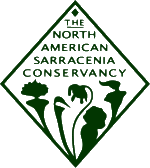
The North American Sarracenia Conservancy (NASC) is a 501(c)(3) non-profit organization dedicated to habitat conservation. Founded in 2005, the Conservancy was granted tax-exempt status in January 2009. The main focus of the Conservancy is the conservation and preservation of the natural habitats and genetic diversity of the Sarracenia pitcher plants. Sarracenia is a genus of carnivorous plant that trap prey in tube-shaped, hollow leaves, which in some species hold rain water. Species range from the southeastern United States, up the coastal plain, and into the Great Lakes and Canada. Within their range the plants naturally occur in sphagnum bogs, swamps, fens, and flooded plains.

Sarracenin is an iridoid found in several plant species in the carnivorous family Sarraceniaceae. It also occurs in other non-carnivorous plants such as Strychnos spinosa (Loganiaceae) and Patrinia heterophylla (Caprifoliaceae).




